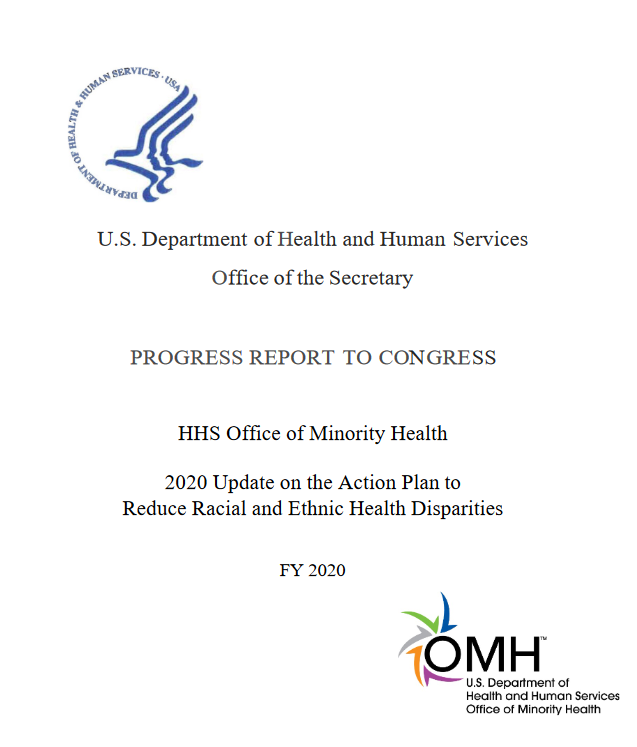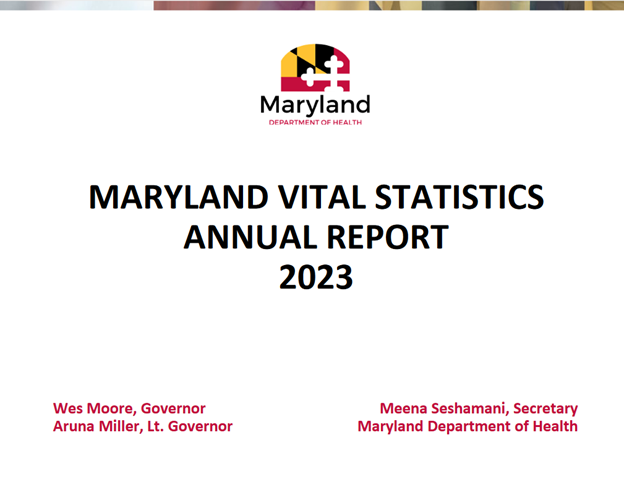Online Course
NRSG 780 - Health Promotion and Population Health
Module 5: Health Disparities / Cultural Competence
Federal & State Initiatives to Reduce Disparities
HHS Action Plan to Reduce Racial and Ethnic Health Disparities
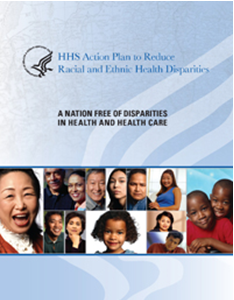 In 2011, the U.S. Department of Health and Human Services (HHS) developed a report on disparities in health care, titled the HHS Action Plan to Reduce Racial and Ethnic Disparities: A Nation Free of Disparities in Health and Health Care.
In 2011, the U.S. Department of Health and Human Services (HHS) developed a report on disparities in health care, titled the HHS Action Plan to Reduce Racial and Ethnic Disparities: A Nation Free of Disparities in Health and Health Care.
This report describes the goals and actions HHS plans to take to reduce health disparities. It details evidence-based programs and initiatives to reduce racial and ethnic disparities.
The vision of the HHS Disparities Action Plan is:
“A nation free of disparities in health and health care.”
The HHS Disparities Action Plan proposes a set of Secretarial priorities, pragmatic strategies, and high-impact actions to achieve strategic goals for the Department. The five goals from the HHS Strategic Plan for Fiscal Years (FY) 2010-2015 provide the framework for the HHS Disparities Action Plan. They are:
- Transform health care
- insure the uninsured, make coverage more secure for those who have it and improve the quality of care.
- Strengthen the nation’s Health and Human Services infrastructure and workforce;
- increase the capacity of providers and systems to address disparities
- support cultural competence
- prepare a workforce that reflects the diversity of the population (e.g., Hispanics are 16% of the population but less than 6% are physicians)
- Advance the health, safety, and well-being of the American people
- Increase availability of community-based programs and policies
- Advance scientific knowledge and innovation
- Increase the efficiency, transparency, and accountability of HHS programs.
Key Disparity Measures – calculated by race, ethnicity and income
| I. Transform health care |
|---|
| % of the U.S. nonelderly population (0-64) with health coverage |
| % of people who have a specific source of ongoing medical care |
| % people who did not receive or delayed getting medical care due to cost in the past 12 months |
| % people who report difficulty seeing a specialist |
| % people who reported that they experienced good communication with their health care provider |
| rate of hospitalization for ambulatory care-sensitive conditions |
| % adults who receive colorectal cancer screening as appropriate |
| II. Strengthen the nation’s Health and Human Services infrastructure and workforce |
|---|
| % clinicians receiving National Health Service Corps scholarships and loan repayment services |
| % degrees awarded in the health professionals, allied and associated health professionals fields |
| % practicing physicians, nurses, and dentists |
| III. Advance the health, safety, and well-being of the American people |
|---|
| % infants born at low birth weight |
| % people receiving seasonal influenza vaccination in the last 12 months |
| % adults and adolescents who smoke cigarettes |
| % adults and children with healthy weight |
In 2020 HHS updated the Action Plan, reaffirmed its goals, and highlighted three priority areas:
- The Opioid Crisis
- Maternal and Infant Health
- COVID-19 Recovery
To learn more about the 2020 Action Plan to Reduce Racial and Ethnic Health Disparities, review the report available at https://cg-b88759ce-d31b-439a-9898-092a58f9927c.s3.us-gov-west-1.amazonaws.com/s3fs-public/documents/Update_HHS_Disparities_Dept-FY2020.pdf
National Partnership for Action
 The National Partnership for Action (NPA) was “established to mobilize a nationwide, comprehensive, community-driven, and sustained approach to combating health disparities and to move the nation toward achieving health equity.” (NPA, 2011)
The National Partnership for Action (NPA) was “established to mobilize a nationwide, comprehensive, community-driven, and sustained approach to combating health disparities and to move the nation toward achieving health equity.” (NPA, 2011)
The focus of the NPA is on social, behavioral, environmental, and biological determinants of health through community engagement, leadership and partnerships.
The Mission
“The mission of the NPA is to increase the effectiveness of programs that target the elimination of health disparities through the coordination of partners, leaders, and stakeholders committed to action.” (NPA, 2011)
The Goals
“The goals of the NPA and its National Stakeholder Strategy for Achieving Health Equity are:
- Awareness - Increase awareness of the significance of health disparities, their impact on the nation, and the actions necessary to improve health outcomes for racial, ethnic, and underserved populations.
- Leadership - Strengthen and broaden leadership for addressing health disparities at all levels.
- Health System and Life Experience - Improve health and healthcare outcomes for racial, ethnic, and underserved populations.
- Cultural and Linguistic Competency - Improve cultural and linguistic competency and the diversity of the health-related workforce.
- Data, Research, and Evaluation - Improve data availability and coordination, utilization, and diffusion of research and evaluation outcomes.” (NPA, 2011).
Disparities in Maryland
Health disparities in Maryland have decreased over the past decade. However, disparities remain as noted in the graphic below.
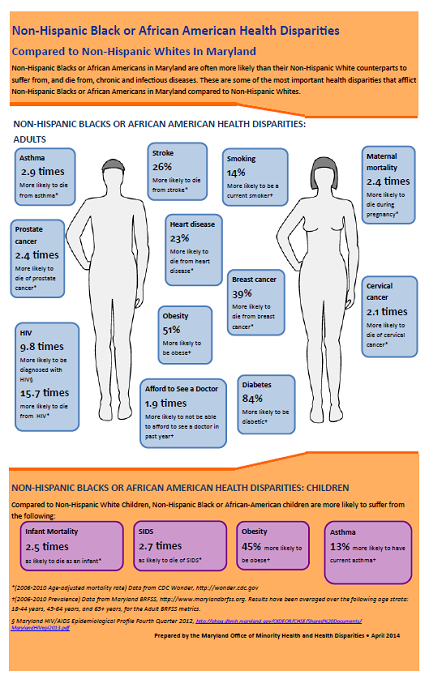
Source: https://health.maryland.gov/mhhd/Pages/Health-Equity-Data.aspx
Mortality rates have declined for all leading causes of death with the exception of the Hispanic population, although mortality among Hispanics remains significantly lower than other population groups.
DISEASES OF THE HEART
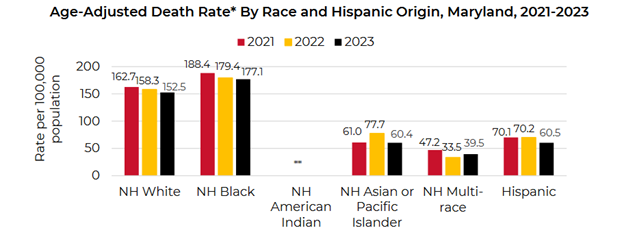
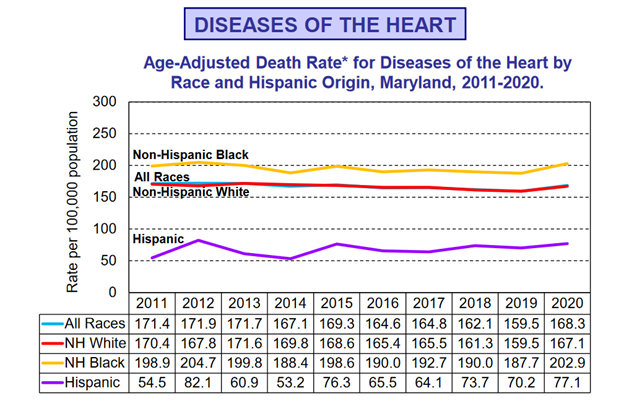
MALIGNANT NEOPLASMS
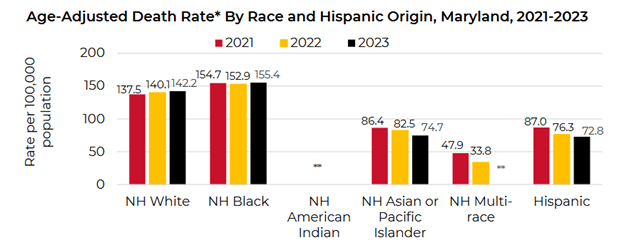
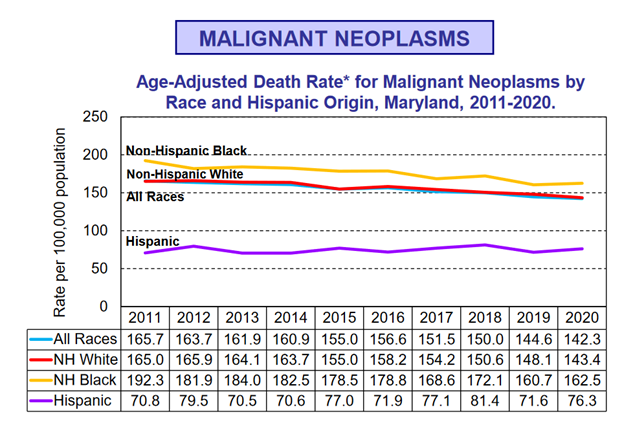
ALL CAUSES
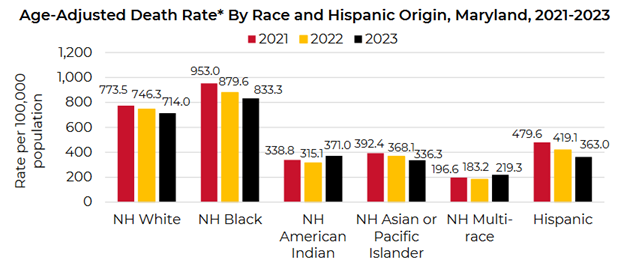
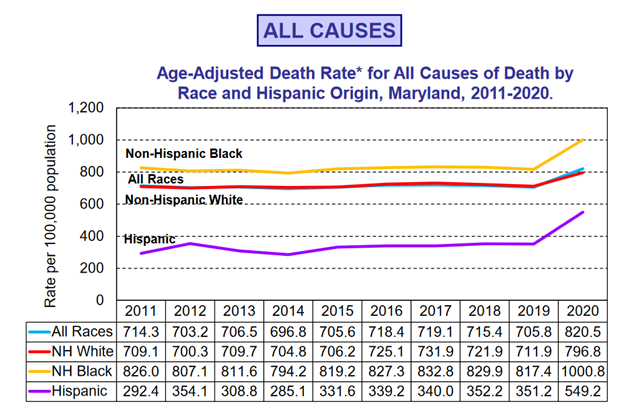
Source:
Sources:https://health.maryland.gov/vsa/Documents/Reports%20and%20Data/Annual%20Reports/2023_Annual%20Report_Final.pdf and https://health.maryland.gov/vsa/Documents/Reports%20and%20Data/Annual%20Reports/2020Annual.pdf
For additional information, please review the 2023 Maryland Vital Statistics Annual Report at https://health.maryland.gov/vsa/Documents/Reports%20and%20Data/Annual%20Reports/2023_Annual%20Report_Final.pdf, the 2020 Maryland Vital Statistics Report at https://health.maryland.gov/vsa/Documents/Reports%20and%20Data/Annual%20Reports/2020Annual.pdf, and the Maryland Office of Minority Health and Health Disparities 2022 Annual Report at https://health.maryland.gov/mche/Documents/MCHE%20Annual%20Report%20-%20Final.pdf
Costs of Health Disparities in Maryland
Johns Hopkins University and the University of Maryland carried out a study in on The Economic Burdens of Health Inequalities in the United States, where they analyzed Medical Expenditure Panel Survey data for the years 2002-2006 to determine the cost burden of health inequities.
At that time, they determined that the combined costs of health inequalities and premature deaths in the United States were $1.24 trillion. Subsequent review of Maryland hospital discharge data identified higher rates of hospital admissions for blacks than whites for all ages and higher costs for blacks than whites because on average blacks are sicker than whites on admission resulting in longer and more expensive hospital stays.
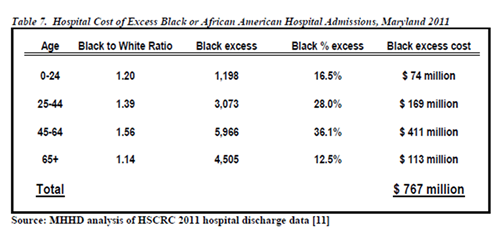
It was this kind of data that 1) lead to legislation in 2004 (HB 86) that officially established Maryland’s Office of Minority Health and Health Disparities in the state’s Department of Health and Mental Hygiene and 2) supported the Maryland Health Improvement and Disparities Reduction Act of 2012 (SB 234) which provided $4 million toward a pilot program to decrease health disparities throughout the state. The funding supports improving health care access and outcomes and lowering health costs and hospital readmissions.
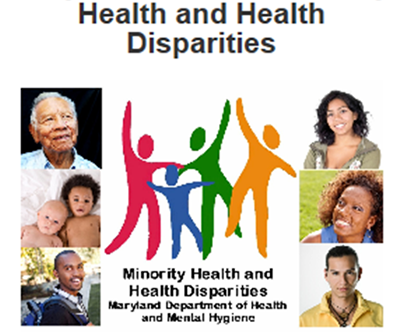
The Office of Minority Health and Health Disparities focuses on improving the health of all Marylanders by promoting health equity among African-Americans, Asian-Americans, Hispanic/Latino Americans and Native Americans. Its goal is to eliminate health disparities, build partnerships to develop health policies, implement programs and track and report progress to the public.
For more information, check out the website at https://health.maryland.gov/mhhd/Pages/home.aspx
This website is maintained by the University of Maryland School of Nursing (UMSON) Office of Learning Technologies. The UMSON logo and all other contents of this website are the sole property of UMSON and may not be used for any purpose without prior written consent. Links to other websites do not constitute or imply an endorsement of those sites, their content, or their products and services. Please send comments, corrections, and link improvements to nrsonline@umaryland.edu.
